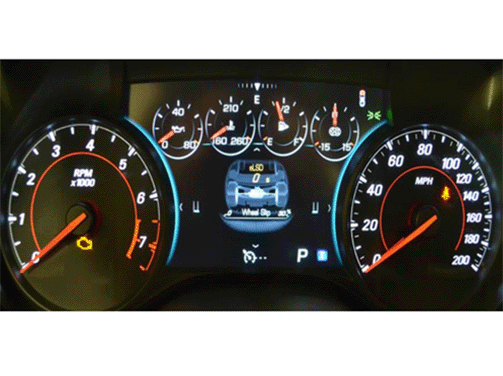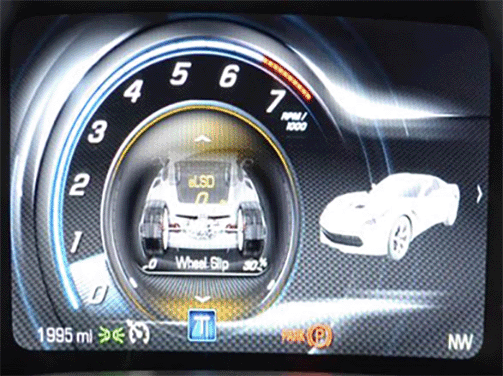eLSD Coupling Percentage
The eLSD system is a relatively new piece of technology that has been introduced to a very limited number of performance vehicles. The goal of this system is to provide an open differential when needed (0%), and a locked differential (100%) when conditions call for it. This system is capable of adjusting the coupling from fully open to fully locked in as little as .15 seconds.
Generally speaking, the eLSD system has an incredible effect on the vehicle’s performance and handling. When the driver is off the throttle, more eLSD coupling adds stability, to a point. When the two rear wheels are clutched together, in a turn, we are slowing down the outside wheel and speeding up the inside wheel. This keeps the vehicle feeling agile throughout the turn.
When the driver is on the throttle, the eLSD system can shift the torque from the inside wheel to the outside wheel to minimize inside wheel spin, as well as provide a much better "feel" on how the car turns with the throttle. More (but not too much) torque applied to the outside wheel will help the car turn.
The respective DIC pages, as seen in the photos above, are provided to the driver so that he or she can monitor the % of coupling that the eLSD is currently at. This is indicated by the yellow number on the top of the DIC screen.
Here are some examples of what the driver may see while monitoring this screen as it relates to the eLSD system:
- Driving straight down the road - The eLSD system will have a bit of coupling to add stability and on-center steering feel. This will be a relatively small amount (around 10% - 15%) and the number will decrease slightly when making a lane change or other steering input.
- When applying the throttle - The system will increase the coupling under heavy throttle. The driver may see around 40 - 50% coupling under heavy acceleration in a track setting. This is to maximize rear traction while cornering, while still maintaining the feel of how the car handles throughout the turn.
- Extreme lane changes and slalom events - The largest coupling will occur during the most aggressive dynamic maneuvers. The eLSD clutches will nearly lock (100%) to add stability at the right moment but open back up to allow the vehicle to steer through a double lane change at precisely the right times.
- Winter driving - If the vehicle is being driven in the winter (being equipped with the appropriate tires), and the driver is attempting to accelerate from a stop with one wheel on ice and the other on dry pavement, he or she will notice that the clutch torque will increase on the DIC as a result of the single wheel slipping. This will transfer torque to the wheel with more available traction so that the vehicle will accelerate smoothly.
- Bleed events - Because the eLSD system is filled with fluid, small amounts of air will accumulate in the system over time. A small actuator is built into the system in order to bleed these small amounts of air from the system. Every few key cycles, the driver may notice that the coupling percentage on the DIC spikes up to 100% briefly. This will occur at very low speeds and also while driving in a straight line. This is completely normal and in no way does this indicate a problem with the system.
There are many different algorithms, or calculations used by this system. The amount of coupling that the system delivers depends on many different factors. They include (but are not limited to) vehicle speed, throttle position, steering angle, yaw rate, available traction, vehicle options, and Performance Traction Management (PTM) mode. Each package is tuned or calibrated individually, so, for instance, the operation is not exactly the same between a Corvette Z06 and a Corvette Stingray with the Z51 package. Vehicles equipped with automatic and manual transmissions have different eLSD calibrations, as do cars equipped with different suspension and tire combinations.
A technician diagnosing a perceived fault with this system MUST obtain very specific information from the customer, and if a comparison vehicle is used, it is imperative to obtain a car that is built with EXACTLY the same options.
Wheel Slip Percentage
On the DIC screen for the eLSD system, there is also a place for monitoring wheel slip. This can be viewed as the white number at the bottom of the DIC page, located on the 0 - 30% scale.
The purpose of this information is to notify the driver as to how much rear wheel slip the vehicle is currently experiencing. A few special notes on this system will help prevent a misdiagnosis on the technician’s part when dealing with customer questions on this reading. This graph actually has nothing to do with the eLSD system. This is an independent calculation, and it is not an indication of the slip inside the eLSD clutches.
The % of wheel slip is calculated by using the average of the rear wheel slip as compared to the average of the front wheel slip. This information is generally not accurate below vehicle speeds of 20-30 mph (32-48 km/h), so when driving a slower speeds, the customer may notice that the graph briefly maxes out at 30%. This actually indicates normal operation. The reason for this is as follows: because this calculation is displayed as a percentage and not an actual value, if the front wheels are traveling at 2 mph (3 km/h) and the rear wheels are showing 3 mph (5 km/h), this indicates a 50% difference in speeds. As this graph is capped at 30%, the bar graph will "max out" in this type of scenario. When traveling at these speeds, actual wheel slip will not even be felt by the driver, even though it appears drastic on the graph. This is simply the result of the math behind the system.

